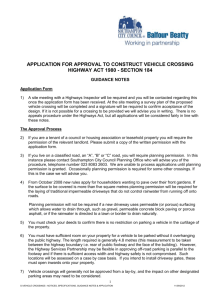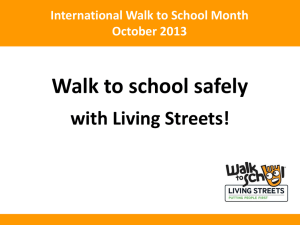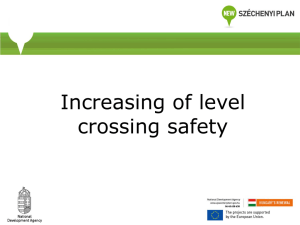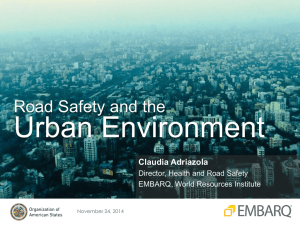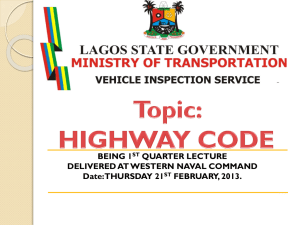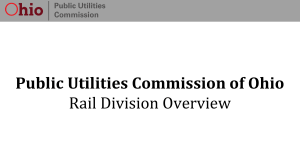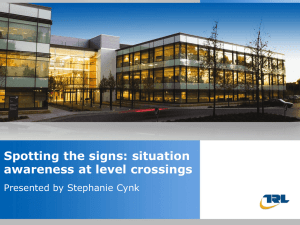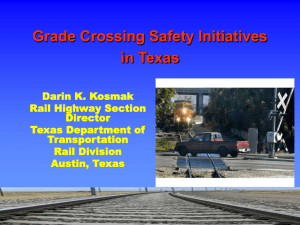Presentation - International Rail Safety Conference (IRSC)
advertisement
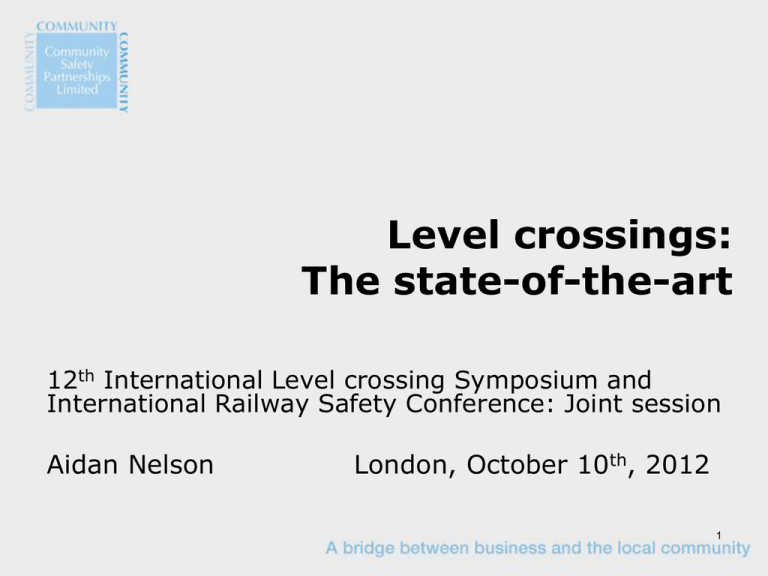
Level crossings: The state-of-the-art 12th International Level crossing Symposium and International Railway Safety Conference: Joint session Aidan Nelson London, October 10th, 2012 1 This paper This paper was commissioned by the Rail Safety and Standards Board (RSSB) It sets out the authors personal interpretation of that which constitutes best practice in the management of risk at level crossings It concludes that the state-of-the-art is a composite of elements drawn from many jurisdictions Suggests where you might look for ideas to adopt in your own risk management programmes May prompt others to offer further examples of good practice How do we measure level crossing safety? Simplistically, the answer is we don’t all agree on the metrics to use What’s more we don’t all capture data to the same specification Differentiated approach to addressing intentional death dimension Important to understand level crossing risk in context of wider road and rail safety contexts Small proportion of road safety deaths Much larger component of train accident risk So what is good performance? Broadly comparable data for 37 countries Countries self-selected based on ease of accessing required data Level crossing fatalities per million population Highway fatalities per million population Fatalities per thousand level crossings Level crossing fatalities as a percentage of highway fatalities Results are generally average of five years’ data Analysis will be repeated to include 2011 data Better performance Crossing fatalities per million population Highway fatalities per million population Fatalities per thousand crossings Crossing fatalities as a % of highway fatalities 1 United Kingdom (0.16) Netherlands (39.69) Canada (0.62) Italy (0.20) 2 Ireland (0.18) Sweden (42.41) Ireland (0.74) 3 Italy (0.19) United Kingdom (42.70) Sweden (0.90) South Africa (0.27) Ireland (0.28) 4 Norway (0.20) Switzerland (46.63) Switzerland (0.95) United Kingdom (0.37) 5 Israel (0.27) Norway (47.10) Czech Republic (1.32) Norway (0.43) 6 Spain (0.32) Israel (50.28) United States (1.43) Bulgaria (0.50) 7 France (0.57) Germany (54.23) United Kingdom (1.48) Greece (0.64) 8 Germany (0.61) Denmark (58.59) Australia (1.57) 9 10 Bulgaria (0.67) Canada (0.72) Denmark (0.72) Finland (60.11) Ireland (64.07) Italy (1.82) France (1.94) United States (0.82) France (0.82) Serbia (0.82) Worse performers Crossing fatalities per million population Highway fatalities per million population Fatalities per thousand crossings Crossing fatalities as a % of highway fatalities 37 Croatia (6.00) South Africa (276.51) India (66.77) Slovenia (3.24) 36 Slovenia (3.45) Lithuania (160.41) South Africa (31.96) Austria (2.95) 35 34 33 Argentina (3.30) Latvia (154.99) Hungary (2.96) Greece (132.69) Slovakia (2.78) Romania (129.56) Israel (20.83) Croatia (17.26) Portugal (13.60 Hungary (2.91) Slovakia (2.88) Czech Republic (2.63) 32 31 Austria (2.31) Estonia (2.24) Poland (129.45) United States (121.14) Lithuania (12.45) Argentina (9.57) Finland (2.60) Argentina (2.51) 30 29 28 Lithuania (1.99) India (1.93) Latvia (1.87) Estonia (117.82) Slovenia (106.31) Hungary (102.02) Estonia (9.09) Slovenia (7.51) Romania (7.33) Australia (2.46) Netherlands (2.12) India (1.97) Measured performance Only two jurisdictions in “top ten” on all four comparative metrics Only one jurisdiction in “bottom ten” Eight jurisdictions appear in both “top ten” and “bottom ten” Low incidence of crossing fatalities per million population increases intolerance of level crossing accidents Low percentage of highway fatalities makes engaging highway sector difficult Important to demonstrate continuous improvement so far as is reasonably practicable The Five Es Enabling Engineering Education Enforcement Evaluation Originated as the 3E Operation Lifesaver model Expanded by Railway Safety / RSSB in UK If not explicit, these elements are implicit within most jurisdictions Enabling frameworks Unified road and rail administrations level the playing field Voluntary road-rail partnerships Documented road-rail interface agreements Single cathartic events can change the approach quickly Specially funded national closure programmes Research, a good case for wider collaboration Sound risk models, used to inform structured professional judgment Rail needs to take the lead Engineering Grade separation appropriate to use, don’t overengineer “Sealed” crossings, an option sometimes ignored Driving down the cost of upgrades – wide variation today Train detection, think laterally Not a stand-alone panacea But, must be able to demonstrate progress and show sound judgment in addressing crossing configuration / elimination to counter media witch-hunts and regulatory intervention Education Branded national programmes Lifesaver and Australasian foundation approaches are good Publicly funded programmes can often get free public service announcement broadcasts, where privately funded programmes have to pay ILCAD is achieving great things already as can national safety weeks Social media is increasingly important Distraction is an issue that cannot be ignored Good safety record at level crossings can cause public funding to be redirected to address other highway safety issues Enforcement Joint initiatives work best Officer on the Train A crossing safety blitz can be a route for local / highway police to address other issues Photo enforcement is an opportunity that too many jurisdictions are missing Punishment to fit the crime requires distinction between accidental and wilful misuse The catastrophic potential of a collision between a train and a road vehicle must inform sentencing There is a lot to do to raise penalties, particularly for wilful misuse of level crossings Evaluation A generally neglected area Effectiveness of engineered solutions needs to be determined on a location specific and programme basis A Broad purview needed when considering efficacy of education programmes Education targeting users of specific crossings needs to be evaluated too Demonstrating value-for-money is key to future funding of engineering, education and enforcement programmes Where is the state-of-the art to be found? Elements of best practice are widely distributed Mix and match what is already working elsewhere Avoid the “not invented here” syndrome Action taken after an accident is important, but it is better to have addressed the risk before the cathartic accident occurs Reduce risk only so far as is reasonably practicable (SFAIRP) I’ll now explain my personal ideal of a comprehensive level crossing risk reduction programme An ideal programme (1) Managing level crossing risk in a country with the best level of road safety The Netherlands, Sweden and United Kingdom for example Unified road and rail administration applying the same criteria to both modes Sweden and Finland stand out Having an enabling framework within which the rail sector is prepared to take the lead in building partnerships Australia, The United Kingdom, Canada and United States for example A quality research programme Australia, Canada, United States and United Kingdom spring to mind Having access to a risk model to support decision making The United Kingdom, Ireland, Australia and Portugal for example Access to truly lower cost level crossing systems An ideal programme (2) Strong government support and funding to allow grade separation projects to proceed and significant numbers of public highway crossings to be eliminated or upgraded Spain, Portugal and the United States for example A single problem solving toolkit used by all stakeholders The Swedish OLA approach stands out; Objective facts, solutions and actions is the English translation Should be backed-up with interface agreements as used in Australia A national public education programme, committed to the use of new media, targeting new risks as they emerge Australasian foundations, Operation Lifesaver where Estonia really stands out Full use made of photo-enforcement and penalties that fit the crime The United Kingdom and South Africa respectively An ideal programme (3) Excellent data to inform evaluation A role for industry safety bodies – RSSB in the UK and RISSB in Australia A regulatory environment equally effective in targeting improvements and remedial action in road and rail sectors An independent accident investigation body that looks at the whole picture and doesn’t see level crossing accidents as a rail only phenomena The same test applied to making recommendations for attention of railway and highway interests Risk reduction only so far as is reasonably practicable The enthusiasm & passion generated through international cooperation leading to improvements in my approach No more humbling experience of railways being pilloried for failing to manage risk arising at level crossings properly Contact Aidan Nelson Email: aidannelson@comsafetypartmers.com Telephone: +44 1904 448439 Mobile: +44 7939 546980
